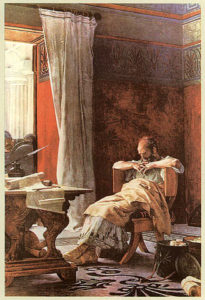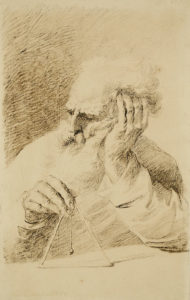
Some might claim that the two phrases that I used to describe Archimedes in the title of this post say the same thing. Even though mathematicians have the reputation of being strange, I am honored, but humbled to claim the mantle of a mathematician. The roles and duties of a mathematician are to identify and solve problems, to quantify and count those things that can be enumerated, to unfold and qualify those things which can’t be enumerated, and to discover and disseminate the beauty of patterns within this world.

It is a big job. However, I was called to this vocation and I love it. I know that my mathematical accomplishments will hold a candle to those of Archimedes. Nevertheless, I count it a privilege to work in the shadow of Archimedes, Pythagoras, and so many others.
According to the many legends about Archimedes, the opening sketch shows him in what would have been a typical pose for him: deep in thought pondering a mathematical, geometric, or engineering problem, tinkering with some toy, piece of equipment, or prototype. Archimedes was the archetypical professor, preoccupied in his thoughts to the exclusion of everything else.
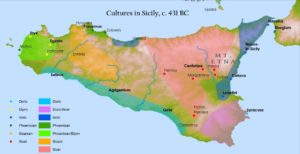
It is believed that Archimedes was born sometime in the year 287 BC, in the city of Syracuse on the island of Sicily. His father, Phidias, was a well-known astronomer and mathematician, and a relative of the King of Syracuse. As a young child, Archimedes was tutored by the best teachers in Italy. In his teen years, he reportedly traveled to Egypt and studied under their greatest teachers, mathematicians, scientists, and engineers. In his early twenties, he returned to Syracuse where he lived the remainder of his life, solving problems and corresponding with his Egyptian colleagues.

I first became acquainted with Archimedes as a fourth-grader, when our teacher introduced the topic of levers during a science lesson on simple tools. The teacher began his demonstration by using an exaggerated statement he attributed to Archimedes: “Give me a place to stand and a lever long enough, I can move the world.”
In the mid-1950s, at least five years prior to human space travel, we all knew that this was a physical impossibility. But it actually made some sense, as we constructed our own levers to move objects.
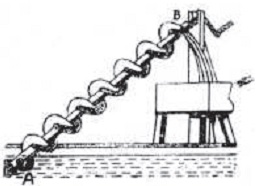
By the time our teacher introduced the Archimedes screw in a subsequent lesson as an example of another simple tool, I was hooked. I was an Archimedes fan.
This guy rocked. One year earlier, I had “helped” my father build an automatic stoker for the coal furnace in our house using an auger that he bought from a farmer that no longer needed it to carry feed to the milking herd that he had sold. That auger was an exact replica of Archimedes’ screw. My father used it to move coal horizontally rather than moving water vertically.

As our teacher told us more about Archimedes, I found that he would take both seemingly simple and complex, real-world problems and use the principles of engineering, physics, and mathematics to solve them. As our teacher systematically detailed the six steps in Archimedes’ method for solving problems, they were indelibly fixed in my mind.
Although I may have demonstrated some of the engineering brilliance of Archimedes, I haven’t yet talked about any of his mathematical work or any of his eccentricities. What were some of the mathematical problems that Archimedes attacked and solved?
It was well known by the time of Archimedes that there was a constant relationship between the radius of a circle and both its circumference and area. We now know this constant as pi or π. Although the use of the Greek letter π was not adopted for general use until the 18th century AD, for the sake of brevity and clarity I will use it for the remainder of this blog. Since Archimedes was generally considered the first to document an attempt to approximate this constant as closely as possible, it is sometimes called Archimedes’ constant.
By 1900 BC, Babylonians had estimated that π was approximately 25/8. In the same time period, Egyptians began using a value of 256/81. The decimal representation of fractions can be traced back to China by the 4th century BC, before slowly spreading through Asia, to the Middle East, and then to Europe. Europeans didn’t fully adopt this approach to expressing non-integral values until they had embraced the base-ten, positional Hindu-Arabic number system that we use today. Thus, we can say that the Babylonians estimated that π was approximately 3.125, while the Egyptians estimated that π was approximately 3.1605.
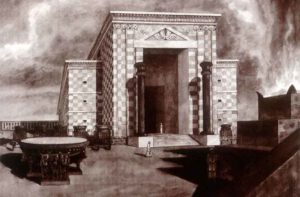
A millennium later we find the ancient Israelites using “3” as an estimate of π in a Biblical reference related to the design of Solomon’s temple.
And he made a molten sea, ten cubits from the one brim to the other: it was round all about, and his height was five cubits: and a line of thirty cubits did compass it round about. (I Kings 7:23, KJV)
The molten sea was actually a large bronze basin filled with water meant to symbolize the chaos of the world during creation when God’s spirit moved upon the waters.
And the earth was without form, and void; and darkness was upon the face of the deep. And the Spirit of God moved upon the face of the waters. (Genesis 1:2, KJV)
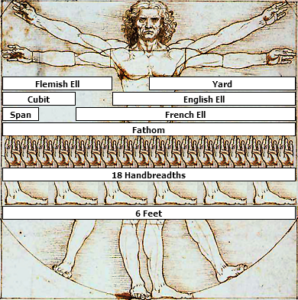
Simple mathematics would tell us that if the diameter of the basin was 10 cubits and its circumference was 30 cubits, the ratio of circumference to diameter was “3.” This is “short” of our current value of π. However, there is a “fudge” factor built into the biblical account. A cubit was never a precise measurement. A cubit was generally considered the length of the forearm of a typical man which is the distance from the elbow to the tip of a man’s middle finger. It was generally about 18 inches or 44 centimeters. However, it could vary with each person making the measurement.
This imprecision didn’t sit well with mathematicians or builders. Although a few mathematicians worked on this problem, it took almost another millennium for Archimedes to come up with a different approach to the problem.
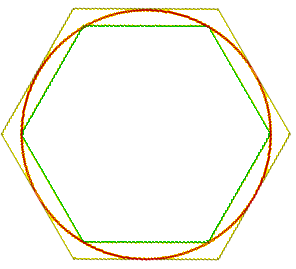
Archimedes tackled the problem of calculating the circumference of a circle using an iterative approach and an over-and-under perspective. He inscribed and circumscribed hexagons inside and outside a circle with a diameter of 1. He was able to calculate the circumferences of the two hexagons, using only the following two results:
1. Pythagorean Theorem: The square of the hypotenuse of a right triangle is equal to the sum of the squares of the other two sides.
( a2 + b2 = c2 )
2. Proposition 3 of Book IV of Euclid’s Elements: If an angle of a triangle be bisected and the straight line cutting the angle cut the base also, the segments of the base will have the same ratio as the remaining sides of the triangle; and, if the segments of the base have the same ratio as the remaining sides of the triangle, the straight line joined from the vertex to the point of section will bisect the angle of the triangle.
Using these two results Archimedes converted the geometric problem to strictly an algebraic problem, howbeit a complicated one. He then iterated the process by successively doubling the number of polygons which inscribed and circumscribed the circle with a diameter of 1. By the time he was using 96 polygons, he had narrowed down the upper and lower limits of π to 3.1408 and 3.1428. This approximation is accurate to two decimal places, which is accurate within 0.4%.

The mathematical problem that Archimedes claimed to be proudest of solving was finding the volume and surface area of a sphere. Archimedes showed that the volume of the sphere has 2/3 the volume and surface of the circumscribing cylinder. Thus, the surface area and volume of a sphere with radius r are given by the equations:
A = 4 πr2
and
V = (4/3)πr3.

Archimedes was so proud of this mathematical accomplishment that he requested that a cylinder encasing a sphere adorn his tomb when he died. This is how the tomb of Archimedes was eventually identified.
In 75 BC, 137 years after Archimedes’ death, the Roman statesman and philosopher Cicero in his Tusculan Disputations Book V, Sections 64 – 66, wrote the following:
When I was questor in Sicily I managed to track down his grave. The Syracusians knew nothing about it, and indeed denied that any such thing existed. But there it was, completely surrounded and hidden by bushes of brambles and thorns. I remembered having heard of some simple lines of verse which had been inscribed on his tomb, referring to a sphere and cylinder modelled in stone on top of the grave. And so I took a good look round all the numerous tombs that stand beside the Agrigentine Gate. Finally I noted a little column just visible above the scrub: it was surmounted by a sphere and a cylinder.
Probably the most famous incident that illustrated Archimedes’ single-mindedness and his eccentricities involved a royal crown and a bath. Archimedes was the go-to-guy in ancient Syracuse to solve problems. Thus, when the Hiero II, King of Syracuse was faced with the suspicion that he had been cheated by a dishonest artisan, he asked for Archimedes’ help.
Heiro II commissioned the creation of a solid gold crown to adorn statues of the gods and goddesses of Syracuse. Since the crown was to be part of a worship activity, Heiro didn’t want to offend the divines. He had to be sure that it was really solid gold, but he couldn’t melt down the crown to find its makeup. So he asked Archimedes to determine a way to test the crown without disturbing or disfiguring it.

In the most famous legend associated with this storying Archimedes was thinking about how to solve this problem while he was taking a bath in one of the public baths of the day. According to the legend, as Archimedes began to submerge himself, he realized that his body mass was displacing an equal mass of water. Here was the solution. Archimedes suddenly screamed “Eureka!” and jumped up and ran home to test his solution. In his haste, he forgot his clothes, so supposedly he was running through the streets of Syracuse naked, yelling “Eureka!” which means “I found it!“
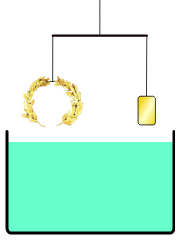
Although there are many versions of this story, I tend to believe the following one is the most plausible. This version is attributed to Vitruvius, a Roman architect of the first century BC. The Archimedes buoyancy principle may have been used to determine whether the golden crown was less dense than gold. Given that both the crown (left) and the reference weight (right) are of identical volume, the less dense reference weight object will experience a larger upward buoyant force, causing it to weigh less in the water and float closer to the surface.

When Syracuse was attacked by Roman naval forces, King Heiro II also commissioned Archimedes to invent weapons to defend the city. According to the legends, Archimedes responded with two monstrous creations. The first was known as the Claw of Archimedes.
It was a giant crane with a long line with a hook that caught the bow of any ship that ventured too close to the seawalls defending Syracuse. By raising and lowering the crane arm, it was able to swamp and/or overturn the boat caught by the hook. It only took one or two encounters with this weapon for the Romans to learn to stay far enough away from the seawall.

With the Roman boats now staying a bowshot away from the shore, Archimedes was challenged to come up with another weapon to defeat this persistent enemy. This led to the legend of Archimedes’ Death Ray. Most every small child knows that using a magnifying glass or a parabolic mirror, one can start a fire from the sun’s rays. According to the stories, Archimedes used this principle to set the Roman ships afire.
Over the intervening centuries, many experiments have been done to try to recreate the incendiary events. In all cases, more mirrors than shown would be needed, and the usual results may have been temporary blindness and confusion among the sailors rather than fire.
Since there are Roman accounts of ships burning and sinking, something probably happened. The mirrors may have consisted of polished metal and had peep-holes drilled in the middle for use in aiming. Whether they set the Roman ship afire, or just created enough confusion so that small crafts from the defenders of Syracuse could get close enough to fling burning vats of “Greece fire,” i.e., burning oil, will never be known.
The Roman commander Marcellus knew through the tales of spies and traitors that the machines that Archimedes had invented caused the problems for his troops. He laid siege to the city and after a protracted period of time, finally wore them down due to the lack of supplies. He ordered his troops to destroy everything and everyone with one exception. Under no circumstances was Archimedes to be harmed. He was to be taken alive. Marcellus wanted this genius working for him.
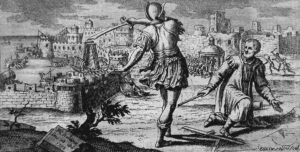
Here is where the single-mindedness of Archimedes got the eccentric in trouble again. A soldier found Archimedes working on a mathematics problem drawing circles in the sand. The soldier ordered Archimedes to come with him. Archimedes told the soldier he couldn’t because he was in the middle of solving an important problem. The soldier started scratching out the sand circles. Archimedes yelled at the soldier “Nōlī turbāre circulōs meōs!” a Latin phrase, meaning “Do not disturb my circles
The soldier got angrier with Archimedes and killed him. When this was reported to Marcellus, he ordered the soldier killed, and Archimedes to be given a burial befitting royalty. Hence the fancy tomb that we had noted that was discovered by Cicero. Archimedes was indeed an eccentric, as well as a mathematical and engineering genius.
In my next post, I will return to considering some of the crisis facing modern American higher education. The next crisis on the agenda is the crisis centered on and created by the Faculty Reward Systems and Faculty Priorities. I hope to post it next week.






